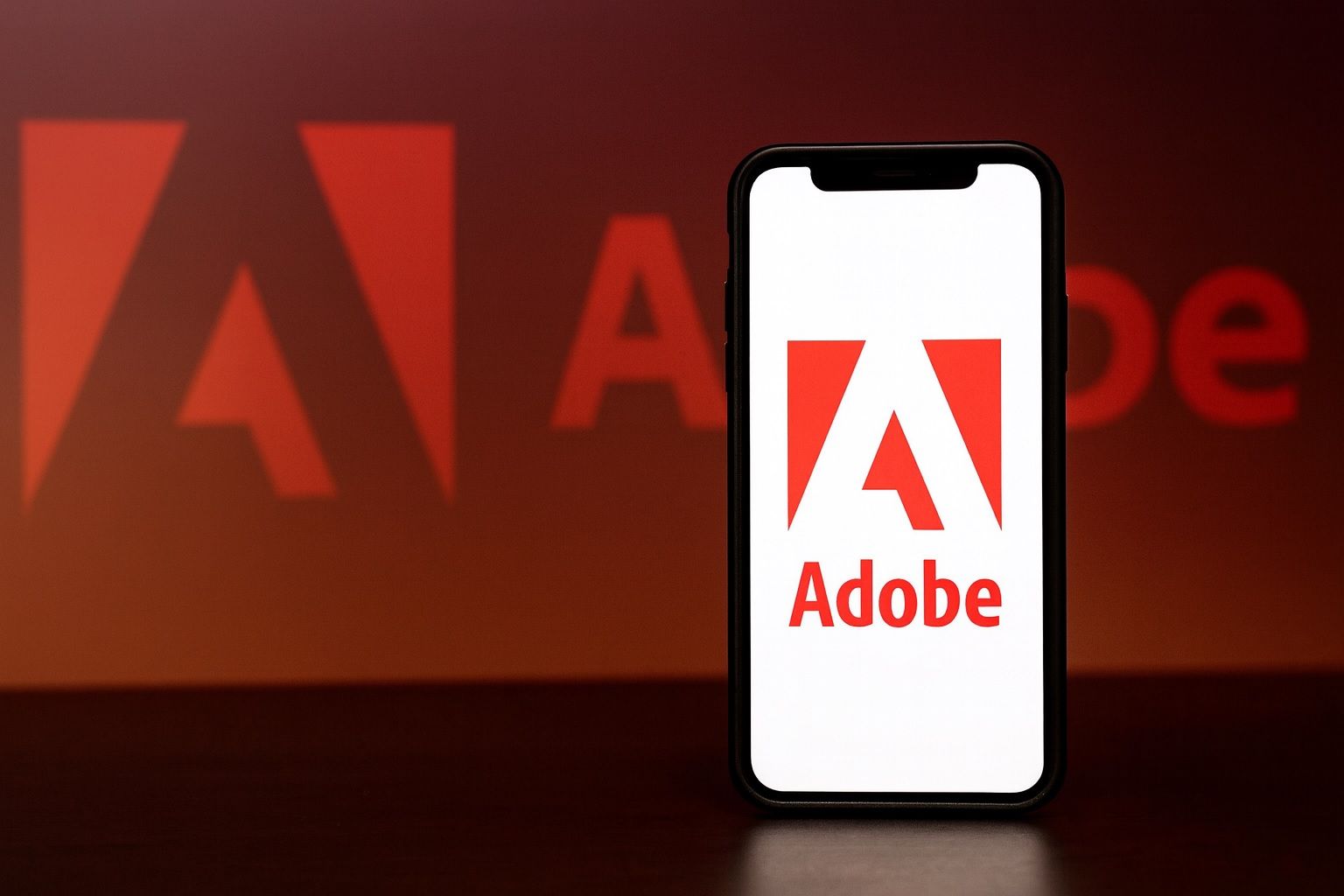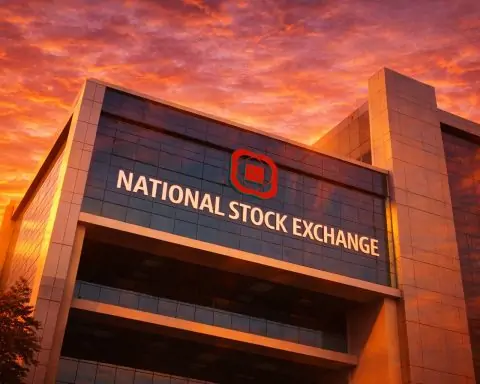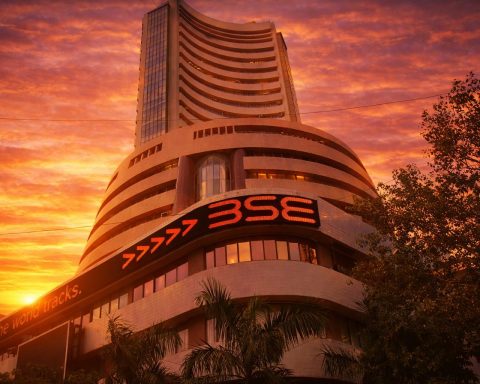- Stock Price: As of Oct. 21, 2025, Adobe Inc. (NASDAQ: ADBE) shares trade around $356, up about 3.9% on the day (Oct. 21) [1]. The stock is down roughly 20–25% year-to-date and recently hit a 52-week low near $329 [2] [3]. In mid-October it traded around $330 [4] before a small rebound into the mid-$350s by Oct. 21 [5].
- Recent Trend: Over the past month ADBE has clawed back ~5% from its lows, but remains far below last year’s highs (~$555) [6]. Technical indicators show Adobe well under both its 50-day and 200-day moving averages [7], reflecting ongoing downward momentum. On Oct. 20 the stock popped ~3% to $343.40 after Adobe unveiled a new AI service (see below) [8].
- Quarterly Results: Adobe reported record Q3 FY2025 earnings on Sept. 11 (quarter ended Aug. 29). Revenue was $5.99 billion (up 10–11% YoY) and adjusted EPS $5.31, beating Wall Street estimates (consensus ~$5.91B/$5.18) [9]. Subscription revenue grew strongly across Adobe’s segments. Management raised its full-year 2025 guidance – revenue now expected at $23.65–23.70B (up from $23.50–23.60B) and EPS $20.80–20.85 (vs. $20.50–20.70 prior) [10]. For Q4 (fiscal), Adobe sees revenue $6.08–6.13B and EPS $5.35–5.40 [11], roughly in line with analysts.
- Product Updates: Adobe is aggressively pushing AI and mobile. On Oct. 20 it launched Adobe AI Foundry, a consulting service to build custom generative AI models trained on each company’s brand assets [12] [13]. Early clients include Disney Imagineering and Home Depot, who say Foundry will accelerate branded content creation at scale [14] [15]. Other recent moves: Adobe released Premiere Pro for iPhone (Sept. 30) to bring professional video editing to mobile [16], and rolled out Acrobat Studio – an “AI-powered knowledge hub” for PDFs – with generative chat features for documents [17] [18]. CEO Shantanu Narayen has emphasized that “every $1 of revenue… should have an AI implication,” underscoring Adobe’s bet on AI-enhanced creative tools [19].
- Analyst Outlook: Wall Street is split. The median 12-month price target is around $460 (range ~$280–$605) [20] [21]. Most analysts rate ADBE a Buy (tickernerd notes 25 Buys, 12 Holds, 3 Sells) [22]. For example, DA Davidson recently kept a Buy rating with a $500 target [23]. By contrast, Morgan Stanley downgraded Adobe to “Equal-weight” (from Overweight) on Sept. 24, cutting its target to $450. Morgan’s Keith Weiss warned that direct AI monetization has “lagged initial investor (and our) expectations,” noting Adobe focused first on adoption and now faces uncertainty in parts of its business [24]. RBC Capital also cut its target (to $430) and echoed concerns that it “will take more time to prove out” Adobe’s AI initiatives [25]. Overall, analyst forecasts imply roughly 15× forward earnings valuation – low by “hot tech” standards – leaving some strategists to say the stock is “compelling value” if AI catalysts do pay off [26] [27].
- Competition & Market Context: Adobe’s stock decline comes amid a tech rally driven by pure-play AI leaders. Chipmaker Nvidia and Microsoft have seen huge gains on AI excitement, while Adobe’s share price lags behind [28]. Analysts caution the software maker is at an “AI crossroads” – it must translate all its AI products into tangible revenue or risk further underperformance [29] [30]. Concerns include intensifying competition: smaller design platforms like Figma (and Canva) plus big tech (Google, Meta) are all incorporating generative AI, pressuring Adobe’s market share [31] [32]. U.S. consumers also seem cautious: Adobe Analytics forecasts U.S. online sales will grow only ~5.3% this holiday season (versus 8.7% last year), a sign of macroeconomic uncertainty [33].
Adobe’s logo displayed on a smartphone. The software publisher’s stock is near 52-week lows despite new AI initiatives. (Image credit: TechStock²)
Stock Performance
Adobe shares have drifted lower for much of 2025. In 2024 the stock peaked around $555 [34], but as of mid-October 2025 it hovered near $330 [35]. That marked a fresh 52-week low (~$329) for ADBE. In the past week (Oct. 15–21) the stock has recovered a bit, closing around $356 on Oct. 21 [36]. This rebound followed announcement of the AI Foundry service (Oct. 20) and some upbeat analyst comments. Still, the year-to-date loss is roughly 20–25%. For context, the Nasdaq index is up ~25% this year; Adobe’s weaker run partly reflects its valuation and profitability relative to faster-growing peers.
Technically, Adobe’s stock is still under pressure. It trades below both its 50-day (~$351) and 200-day (~$369) moving averages [37], a signal that the downtrend remains intact. Over the past month the stock is up ~5–10% from its trough, but that only offsets a fraction of earlier losses. Valuation multiples look modest: about 21× trailing earnings and ~16× forward earnings [38], well below the higher multiples of many AI-era tech stocks. Bargain hunters note that the company generates strong cash flow from its subscription model – for example, cash from operations was $2.2B in Q3 [39] – and Adobe has used excess cash to buy back shares ($2.2B in Q3) and pay dividends. Still, investors remain cautious until the AI investments begin to clearly pay off.
Recent Earnings and Guidance
In its latest quarter (ended Aug. 29, 2025), Adobe delivered record revenue of $5.99 billion [40], up about 10–11% year-over-year. This exceeded analysts’ forecasts (~$5.91B) and was broad-based across segments. Digital Media (Creative Cloud, Photoshop, etc.) revenue was especially strong (+12% YoY), and Digital Experience (marketing software) also grew. Non-GAAP EPS was $5.31, well above consensus ~$5.18 and above last year’s $4.65 [41]. The beat was partly driven by subscription price increases and a rebound in hiring at creative agencies and enterprises.
Management’s tone was upbeat. CFO Dan Durn told Reuters that “new users and subscribers joining the Adobe ecosystem are the predominant drivers of growth and continue to be so” [42]. He noted that generative AI products like Firefly have spurred trial, though Adobe focuses first on adoption and then monetization. With strong results, the company raised its full-year revenue forecast to $23.65–23.70B (from $23.50–23.60B prior) and EPS to $20.80–20.85 (from $20.50–20.70) [43]. For the current quarter (Q4), Adobe guided to roughly $6.08–6.13B revenue and $5.35–5.40 EPS [44], roughly matching street expectations. In sum, the fundamentals (arriving users, recurring revenue growth) look solid – even as Wall Street debate centers on how quickly new AI tools turn into profit.
AI Innovation and Product News
Adobe has doubled down on AI-powered creative tools in 2025. Most recently, on Oct. 20 it unveiled Adobe AI Foundry, a custom-models service for enterprises [45] [46]. In practice, Foundry brings a company’s own logos, brand imagery and data into Adobe’s Firefly AI platform, producing “pixel-perfect, brand-protected” images, videos and other media [47] [48]. Early customers include Disney Imagineering and Home Depot, who say it will let them generate on-brand marketing content at scale [49] [50]. Home Depot’s CMO Molly Battin called Foundry “an exciting step forward” in using AI to deepen customer engagement [51]. Adobe’s VP of GenAI New Business, Hannah Elsakr, says Foundry will make it possible “to put the brand in the hand of the consumer in an on-brand way” [52].
Building on Foundry, Adobe continues to add AI features across its apps. Firefly (launched 2023) now lives inside most Creative Cloud tools, but the company acknowledges it must convert usage into revenue. CFO Durn pointed out that customers are already generating “over 1 billion Firefly assets every month” with these tools [53] – evidence of heavy engagement. But he also admitted that so far this has only slowly translated into profit. Analysts at RBC noted that “it feels like it will take more time to prove out these (AI) initiatives” [54].
Other product news: At the end of September, Adobe brought Premiere Pro to iPhone, enabling mobile video editing with professional-grade tools [55]. It also launched Acrobat Studio, an “AI-powered knowledge hub” that lets users upload PDFs and chat with an AI about the content (summarizing, answering questions, etc.) [56]. This “reinvents PDF for modern work,” says Adobe VP Abhigyan Modi [57]. In 3D, Adobe’s Firefly models are now integrated into NVIDIA’s Edify and Omniverse platforms, reflecting partnerships (rather than direct consumer apps). Overall, Adobe’s strategy is clear: invest aggressively in generative AI and partner with broader AI ecosystems, even if monetization is still ramping. CEO Narayen succinctly captured this goal: to make “every dollar of revenue… have an AI implication” [58].
Market Trends and Competition
Adobe’s struggles are partly a story of market context. In 2025 the stock market’s gains were dominated by the new AI darlings – semiconductor and cloud companies at the forefront of the hype. By contrast, Adobe’s core business (creative software subscriptions) is a more mature growth story. Though the company is now an AI pioneer in its category, some investors worry that other tech giants might steal a march on new capabilities. Indeed, firms like Google have announced major AI upgrades (e.g. Gemini Enterprise in early Oct.) [59] [60], and Microsoft continues to bake AI (Copilot) into Windows and Office [61]. Meanwhile, Adobe’s traditional rivals and upstarts (Canva, Figma, even Meta) have been adding generative tools of their own, intensifying competitive pressure [62] [63].
This competitive backdrop has analysts cautious. CFRA Research’s Angelo Zino warned in June of “increasing concerns surrounding competitive pressures and a longer time horizon to reach notable AI monetization” [64]. An RBC analyst note echoed the sentiment, pointing out that management’s guidance was strong but “it feels like it will take more time to prove out these (AI) initiatives and quiet concerns of competition around GenAI” [65]. In other words, even with strong subscriber growth, investors want to see concrete returns on Adobe’s AI R&D.
Adobe’s products are still industry-leading – Photoshop and Illustrator remain the standard – but the worry is about growth pacing. The broader tech rally also saw concerns about an AI “bubble,” with billions flowing into startups and new projects. If that enthusiasm cools or if interest rates stay high, high-growth tech stocks like Adobe could see further multiple compression. For now, Adobe’s forward price/earnings (~15×) is relatively undemanding, but comparisons with faster-growing peers highlight the stock’s current cheapness as well as the risks if growth slows.
Analyst & Expert Views
Wall Street’s experts are divided on Adobe’s path forward. On the bullish side, many analysts argue Adobe’s entrenched business and growing addressable market justify the stock’s current valuation. Benzinga notes the consensus remains a “Buy,” with a mean price target around $460 [66], implying roughly 30–35% upside from today’s levels. Those bullish estimates point to Adobe’s durable subscription revenues (Adobe has >100M paid users) and say generative AI will eventually accelerate its digital-media sales. One Benzinga note highlights that 35% of Photoshop users already use generative features, suggesting plenty of room to monetize AI tools [67]. The median Wall Street forecast (per tickernerd) indeed sits at ~$460 (range $280–$605) [68] [69].
However, several respected analysts counsel caution. Morgan Stanley’s Keith Weiss explicitly downgraded Adobe, noting in late Sept. that “direct [GenAI] monetization has lagged initial investor (and our) expectations” [70]. He acknowledges Adobe’s core strengths, but warned that if AI-driven growth doesn’t materialize soon, “the stock will languish” [71]. RBC’s Matthew Swanson (now at TD Cowen) cut his price target to $430, citing a lack of “clear visibility” on GenAI’s impact given accelerating competition [72]. CFRA’s Angelo Zino also cautioned that investors are bracing for a longer timeline on AI returns [73]. In short, the debate is whether Adobe’s reinvestment in AI will pay off relatively quickly (as history with mobile and cloud tools eventually did), or whether those gains remain uncertain in the near term.
Industry voices outside Wall Street offer context. For example, Lenovo’s executives praise “agentic AI” as a major productivity shift [74], which indirectly boosts Adobe’s market by making businesses pour into AI infrastructure. But they also underscore how many players are jockeying for enterprise AI dollars. Even within Adobe’s leadership, the message is that AI complements human creativity. As Adobe’s Hannah Elsakr put it in TechCrunch, AI “puts the brand in the hand of the consumer in an on-brand way,” but “our stance is humanity is at the center of creativity and that can’t be replaced” [75] [76]. This suggests Adobe is positioning itself not as an AI pure-play, but as a creative-software company leveraging AI – a distinction with both pros and cons for investors.
Outlook and Forecasts
Looking ahead, near-term catalysts include Adobe’s investor event on Oct. 28, 2025, when management will hold a Q&A at the Adobe MAX conference [77]. Investors will be keen to hear more about AI Foundry plans, AI partnerships (e.g. with Microsoft or others), and any updates on cloud-based services. Seasonal factors may also play a role: Adobe traditionally enjoys a Q4 boost from holiday advertising spending and enterprise IT budgets. However, the company’s own analytics suggest holiday online sales growth will be slower than last year [78], so the macro backdrop is mixed.
For the longer term, Wall Street forecasts vary widely. The bullish camp (top targets ~$550–$600) assumes Adobe can maintain mid-teens subscription growth by winning new customers and lifting prices, with AI adding a fresh revenue kick. Skeptics (bottom targets near $280) assume growth will fade as market saturation hits and competition bites. On balance, the consensus seems to bet on moderate growth: the average analyst projects roughly 10–15% annual revenue growth for the next few years, aligning with Adobe’s recent pace. If those estimates hold, Adobe would still see profits rise each year – but whether the stock climbs in lockstep depends on market sentiment about tech valuations.
For everyday investors, the takeaways are clear: Adobe is a cash-generating leader in creative software, now heavily investing in generative AI. Its near-term stock performance has been weak, reflecting the wait for AI initiatives to bear fruit. Experts agree on Adobe’s fundamental strength (solid recurring revenue, high profit margins) but differ on timing. As one analyst put it, Adobe offers “compelling value” if AI catalysts arrive, but patience will be required [79] [80]. With the launch of AI Foundry and other tools, management is betting the check will come – whether the stock trend reverses quickly may depend on how fast and visibly that happens.
Sources: Recent financial results and guidance from Reuters [81] [82]; stock performance and analyst data from Reuters and TechStock² [83] [84] [85]; Adobe product news from TechCrunch and official releases [86] [87]; expert commentary from Reuters (CFRA, RBC) [88] [89] and research outlets [90] [91].
References
1. www.reuters.com, 2. ts2.tech, 3. www.reuters.com, 4. ts2.tech, 5. www.reuters.com, 6. ts2.tech, 7. ts2.tech, 8. www.ideal-investisseur.fr, 9. www.reuters.com, 10. www.reuters.com, 11. www.reuters.com, 12. ts2.tech, 13. techcrunch.com, 14. ts2.tech, 15. ts2.tech, 16. ts2.tech, 17. ts2.tech, 18. ts2.tech, 19. ts2.tech, 20. ts2.tech, 21. tickernerd.com, 22. tickernerd.com, 23. tickernerd.com, 24. finviz.com, 25. www.reuters.com, 26. ts2.tech, 27. finviz.com, 28. ts2.tech, 29. ts2.tech, 30. finviz.com, 31. www.reuters.com, 32. ts2.tech, 33. ts2.tech, 34. ts2.tech, 35. ts2.tech, 36. www.reuters.com, 37. ts2.tech, 38. ts2.tech, 39. www.adobe.com, 40. www.reuters.com, 41. www.reuters.com, 42. www.reuters.com, 43. www.reuters.com, 44. www.reuters.com, 45. ts2.tech, 46. techcrunch.com, 47. ts2.tech, 48. techcrunch.com, 49. ts2.tech, 50. ts2.tech, 51. ts2.tech, 52. techcrunch.com, 53. ts2.tech, 54. www.reuters.com, 55. ts2.tech, 56. ts2.tech, 57. ts2.tech, 58. ts2.tech, 59. ts2.tech, 60. ts2.tech, 61. ts2.tech, 62. ts2.tech, 63. www.reuters.com, 64. www.reuters.com, 65. www.reuters.com, 66. ts2.tech, 67. ts2.tech, 68. ts2.tech, 69. tickernerd.com, 70. finviz.com, 71. ts2.tech, 72. www.reuters.com, 73. www.reuters.com, 74. ts2.tech, 75. techcrunch.com, 76. techcrunch.com, 77. www.adobe.com, 78. ts2.tech, 79. ts2.tech, 80. finviz.com, 81. www.reuters.com, 82. www.reuters.com, 83. ts2.tech, 84. www.reuters.com, 85. ts2.tech, 86. techcrunch.com, 87. ts2.tech, 88. www.reuters.com, 89. www.reuters.com, 90. finviz.com, 91. ts2.tech








